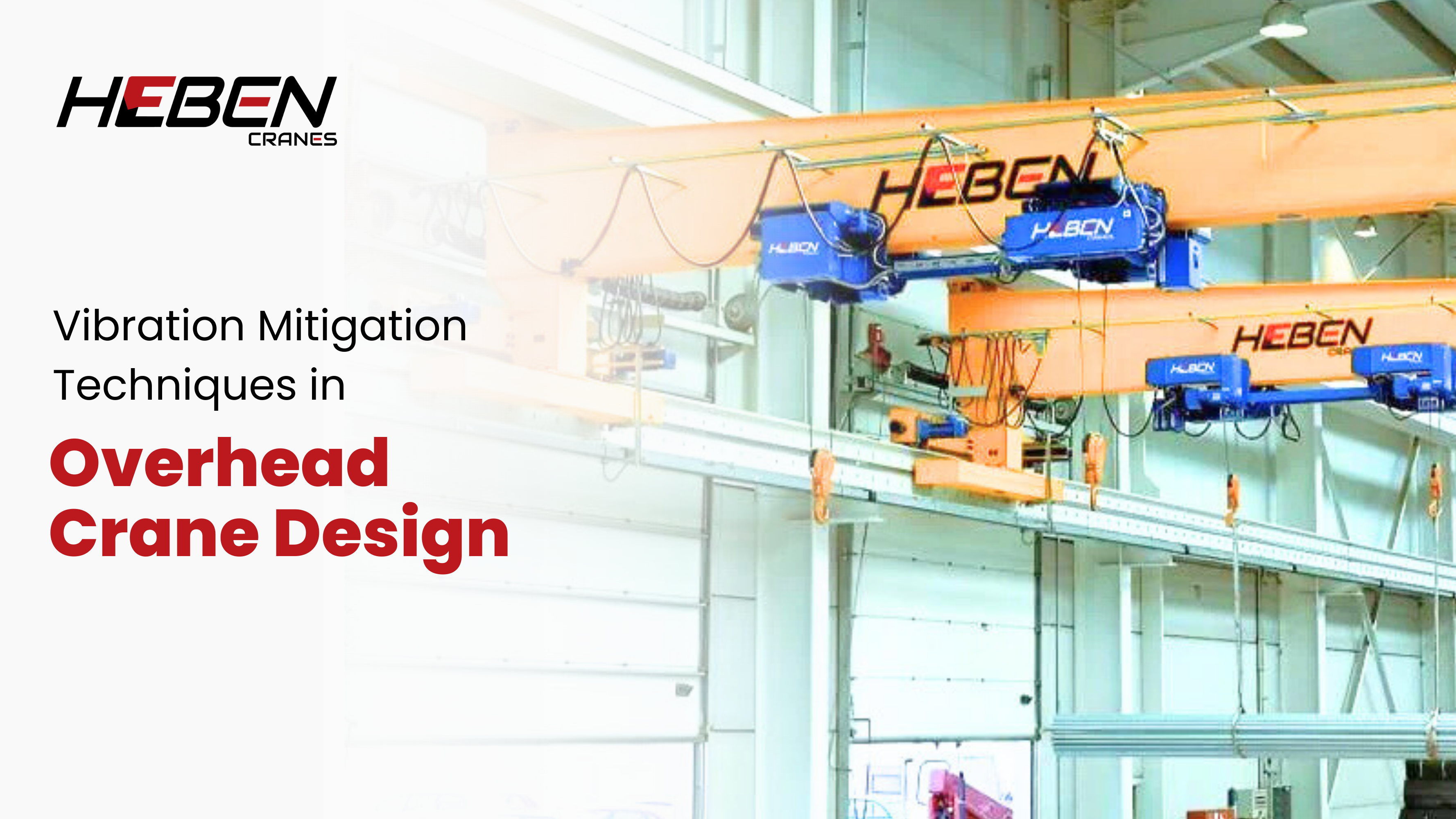Overhead cranes are engineering marvels that move heavy loads with precision and efficiency. Yet even these titans of material handling are not immune to the challenges posed by vibrations. When working with such massive equipment, even small oscillations can have large consequences—from compromised safety and positioning inaccuracies to premature wear on components. Understanding how to mitigate these vibrations deepens our appreciation for the intricacies of crane design and highlights the innovations driving companies like Heben Cranes to lead the market.
In this blog, we’ll explore the fundamentals of crane vibrations, innovative techniques to suppress them, and how Heben Cranes’ cutting‐edge engineering and custom solutions support a safer, more efficient lifting environment.
Understanding Crane Vibrations
Every overhead crane experiences vibrations due to its inherent dynamics. These vibrations can be triggered by various factors—load movements, mechanical imbalances, and even external forces like wind or ground vibrations. Vibrations can arise from load shifts and sudden accelerations, leading to significant oscillations in the mast and trolley. When a load swings excessively, it threatens the precision of positioning and raises the risk of structural damage and operator fatigue.
Sources of Vibration
In crane systems, the primary sources of vibration include:
- Load Movements: As the crane accelerates or decelerates, the suspended load behaves like a pendulum. Even minor shifts in acceleration can excite the natural frequencies of the system.
- Mechanical Imbalances: Manufacturing imperfections, wear over time, or even slight asymmetries in the crane’s structure can create imbalances that manifest as vibrations.
- Environmental Disturbances: External factors such as wind gusts, ground vibrations, and even the dynamic response of the supporting structure (like a building or a mobile platform) contribute to overall vibration levels.
These factors combine in a complex interplay, making vibration mitigation a significant challenge in overhead crane design. Excessive vibrations can lead to inaccuracies, reduced service life, and ultimately compromise safety.
Impact on Operations
The negative effects of uncontrolled vibrations extend beyond simple annoyance. In high-stakes environments, even small oscillations can derail precision operations. For instance, in automated storage and retrieval systems (AS/RS), inaccurate load positioning can lead to misplacements, increased downtime, and costly repairs. Additionally, vibrations contribute to cumulative fatigue on the crane’s structural components—accelerating wear and potentially leading to unexpected failures. In industrial applications where safety and uptime are paramount, understanding and controlling these vibrations is not just an engineering challenge but a critical business imperative.
Innovative Vibration Mitigation Techniques
Engineering solutions for vibration mitigation in overhead cranes have evolved dramatically in recent years. From sophisticated control algorithms to strategic structural design modifications, modern methods offer robust solutions for reducing unwanted oscillations. Let’s dive into three key techniques that represent the forefront of innovation in this area.
1. Input Shaping Control
One of the most exciting developments in vibration mitigation is input shaping control. This technique involves modifying the command signal—the input given to the crane—to minimize residual vibrations. By “pre-conditioning” the motion command, the crane’s response avoids exciting its natural vibrational modes. In essence, rather than fighting the vibrations after they occur, input shaping prevents them from happening at all.
A research paper on overhead crane vibration control describes input shaping as a method that modifies control inputs to reduce residual vibrations during load movements. This technique has been shown to improve the smoothness of motion and enhance precision. For passionate amateurs, it’s fascinating to see how a relatively straightforward concept—adjusting the timing and amplitude of control commands—can yield such significant benefits in system performance.
2. Active Damping Systems
While input shaping works proactively, active damping systems take a more dynamic approach. These systems integrate sensors and actuators that continuously monitor and adjust the crane’s operation in real-time. By detecting oscillations as they occur, an active damping system applies counteracting forces to suppress vibrations immediately.
As described in one research paper, active damping utilizes sensors and actuators to detect and counteract vibrations in real-time, adjusting crane operations dynamically to enhance load stability. The benefit of active damping is its adaptability—no matter how unpredictable the external disturbances, the system can react almost instantaneously. For those intrigued by control theory and real-time system design, active damping represents a perfect marriage of mechanical engineering and electronics, and it offers a glimpse into the future of smart, adaptive machinery.
3. Structural Reinforcement
Sometimes, the best way to reduce vibrations is to address the issue at its source: the crane’s structure itself. Structural reinforcement involves designing or retrofitting crane components to be more resilient to vibrational forces. This can be achieved through material selection, geometry optimization, and the strategic placement of damping elements within the structure.
For example, Heben Light Cranes prominently feature “Minimal Vibration & Noise” as a key benefit. The design philosophy behind these products emphasizes not only load capacity and precision but also the intrinsic ability to dampen vibrations through robust construction. Less vibration and low noise levels are central to its design, which is a testament to the company’s commitment to quality and performance. This focus on structural integrity ensures that the crane performs reliably even under strenuous operating conditions.
Heben Cranes’ Approach to Vibration Mitigation
At Heben Cranes, innovation in vibration mitigation isn’t an afterthought—it’s a cornerstone of their engineering philosophy. The company’s products are designed with a deep understanding of the challenges posed by dynamic loads and environmental disturbances.
Advanced Engineering
Heben Crane’s rigorous approach to design means that every component is analyzed not just for strength and capacity but also for its vibrational characteristics. In the world of material handling, where precision and durability are paramount, Heben’s engineers apply advanced simulation tools and real-world testing to ensure that their cranes can absorb and dissipate vibrational energy effectively. By integrating vibration analysis into the early stages of design, Heben can optimize both the geometry and material properties of their cranes, resulting in a product that delivers superior performance under dynamic conditions.
Product Integration
Heben Cranes’ product lineup is a testament to their commitment to mitigating vibration. For instance, their single-girder and double-girder crane models incorporate innovative damping techniques and structural reinforcements that reduce both vibration and noise. Heben crane kits are “pre-engineered, complete crane systems” that integrate “advanced technology” including anti-sway control systems and adjustable vibration mitigation features. This seamless integration of vibration control mechanisms into their products not only enhances performance but also makes installation and operation easier for end users.
Client-Centric Solutions
Recognizing that every industrial application has its unique challenges, Heben Cranes offers tailored solutions that address specific vibration mitigation needs. Whether you’re operating in a high-speed warehouse environment or on a rugged construction site, Heben works closely with clients to customize crane configurations and control systems. Their client-centric approach means that the vibration mitigation strategies are not one-size-fits-all but are carefully adapted to the operational context.
Benefits of Effective Vibration Mitigation
When vibrations are effectively mitigated, the benefits extend across multiple facets of crane operation. Let’s explore how these improvements translate into real-world advantages.
Enhanced Precision
Reducing vibrations leads directly to improved positioning accuracy. When an overhead crane operates with minimal oscillations, the load can be placed more precisely, reducing errors in storage or assembly operations. Input shaping and active damping techniques have been proven to significantly improve tracking performance, ensuring that the actual load path closely follows the intended trajectory. As highlighted in one study, “precise control of input shaping techniques can dramatically reduce residual vibrations, leading to more accurate load placement”
. For industries that demand high precision—such as semiconductor manufacturing or automated warehousing—this level of control is invaluable.
Increased Safety
Safety is paramount in any heavy-lifting operation, and vibrations can pose serious risks. Excessive oscillations not only endanger the load but also the crane operator and nearby personnel. By minimizing vibrations, the risk of load swing and structural fatigue is reduced, contributing to a safer working environment. Moreover, a quieter, smoother operation means that operators are less likely to be distracted or fatigued, further enhancing overall safety. This focus on safety aligns with Heben Cranes’ commitment to ensuring superior performance and reliability while upholding the highest safety standards.
Operational Efficiency
Vibration mitigation isn’t just about safety and precision—it also has a profound impact on operational efficiency. Cranes that vibrate excessively are more prone to wear and tear, leading to increased maintenance costs and downtime. By designing systems that inherently reduce vibrations, manufacturers like Heben extend the lifespan of their equipment and minimize the frequency of costly repairs. Additionally, smoother operations contribute to faster cycle times, which can significantly improve overall productivity in a high-throughput environment. For companies seeking to maximize their return on investment, these efficiency gains are a crucial advantage.
Conclusion
The Path Forward
As we look to the future, the importance of vibration mitigation in overhead crane design is only set to grow. Advances in control algorithms, sensor technology, and material science are paving the way for even more sophisticated solutions. Researchers are actively exploring new methods—such as adaptive control techniques and machine learning algorithms—to predict and counteract vibrations in real-time. These developments promise to make cranes even more efficient, reliable, and safe, ensuring that they meet the ever-evolving demands of modern industry.
Heben Cranes’ Role
In this dynamic landscape, Heben Cranes stands out as a beacon of innovation. Their relentless pursuit of excellence is reflected in every aspect of their design, from advanced input shaping techniques to integrated active damping systems and robust structural reinforcements. By staying at the cutting edge of vibration mitigation technology, Heben not only delivers products that exceed industry standards but also provides tailored, client-centric solutions that address the specific challenges of each application.
For those passionate about the engineering behind overhead cranes—and for those who appreciate the blend of theory, innovation, and practical application—vibration mitigation represents both a technical challenge and a gateway to improved safety, precision, and efficiency. As you delve deeper into this subject, you’ll discover a world where advanced control algorithms meet rugged, real-world machinery, and where companies like Heben Cranes are leading the charge.
Final Thoughts
Vibration mitigation is not merely a technical detail; it’s a critical aspect of overhead crane design that can influence every facet of operation. With techniques like input shaping control, active damping systems, and structural reinforcement, engineers can create cranes that operate more smoothly, accurately, and safely. For the enthusiastic amateur or the seasoned professional alike, the innovations in this field are a reminder of how far engineering has come—and how much further it can go.
In an era where efficiency and safety are non-negotiable, the ability to control and mitigate vibrations is a game-changer. By integrating cutting-edge technologies and maintaining a commitment to continuous improvement, Heben Cranes exemplifies the future of overhead crane design. As you continue your exploration of this fascinating domain, keep an eye on the advancements in vibration control—they may well redefine the limits of what’s possible in material handling.
The journey toward perfecting crane dynamics is ongoing, and every incremental improvement brings us closer to a future where heavy lifting is not only more efficient but also profoundly safer and more reliable. Whether you’re an industry veteran, a budding engineer, or simply an enthusiast with a keen interest in the mechanics of motion, understanding these techniques provides valuable insight into the world of modern material handling and the engineering marvels that make it all possible.
Embrace the vibration-free revolution and witness firsthand how innovations in input shaping, active damping, and structural design are transforming overhead crane operations—one oscillation at a time.




